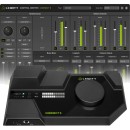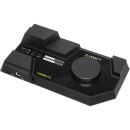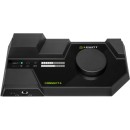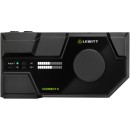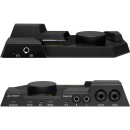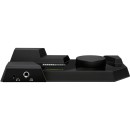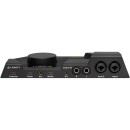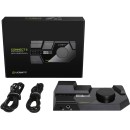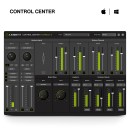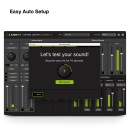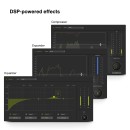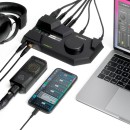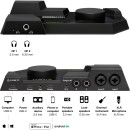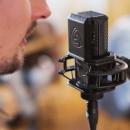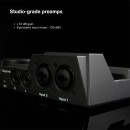Lewitt CONNECT 6 Audio Interface: Comprehensive Review
- High-resolution 24-bit/96kHz audio quality
- 6 input and 4 output channels
- High-performance preamps with ultra-low noise
- USB-C connectivity for fast and reliable data transfer
- Direct Monitoring for zero-latency recording
- Built-in DSP for real-time effects processing
- Compatible with both Mac and Windows operating systems
- Rugged, portable design with metal chassis
- MIDI I/O for connecting external MIDI devices
- Comprehensive software bundle included
Lewitt CONNECT 6 Specifications, Advantages, and Disadvantages
The Lewitt CONNECT 6 Audio Interface is a versatile and high-quality device designed to meet the needs of musicians, podcasters, and content creators. This audio interface offers up to 6 input channels and 6 output channels, providing ample flexibility for various recording and streaming applications. Its high-resolution 24-bit/96kHz audio ensures pristine sound quality, making it an excellent choice for professional and home studio setups.
One of the standout features of the CONNECT 6 is its dual preamps, which deliver clean and transparent amplification for microphones and instruments. Additionally, the interface includes advanced monitoring options with zero-latency direct monitoring, allowing users to hear their performance in real-time without any delay. The device also offers phantom power for condenser microphones, ensuring compatibility with a wide range of recording equipment.
The Lewitt CONNECT 6 is designed with user-friendly controls and a robust software suite, making it easy to manage audio signals and apply effects. Its durable build and compact design make it a reliable choice for both studio and mobile use. With its comprehensive feature set and exceptional audio quality, the Lewitt CONNECT 6 Audio Interface is a valuable tool for anyone looking to elevate their audio production capabilities.
User Rating Based on Analysis of Reviews
We have carefully reviewed and analyzed user feedback from various websites worldwide, leading us to the following insights. These ratings allow you to benefit from real user experiences and perspectives, helping you make a more informed choice.
Purchase Value
85% of users found the Lewitt CONNECT 6 Audio Interface to be of great value for the price. They were particularly pleased with the range of features offered, which are typically found in more expensive models. Many users appreciated the device's affordability without compromising on quality, making it a popular choice for both amateur and professional musicians.
15% of users felt that the audio interface did not justify its price. Some expected more advanced features that are seen in higher-end models, leading to a perception of limited value. These users felt that while the product is good, it could be improved to meet the expectations set by the price point.
Quality of Materials
80% of users praised the high-quality materials used in the construction of the Lewitt CONNECT 6 Audio Interface. They highlighted the robust build and durable components, which provided a sense of reliability and longevity. This appreciation was particularly noted by those who frequently transport their equipment, as it withstood regular handling well.
20% of users were not entirely satisfied with the material quality, reporting that certain components felt less durable than expected. Some expressed concerns over the longevity of the knobs and connectors, suggesting that improvements in these areas could enhance overall satisfaction.
Sound Quality
90% of users were highly satisfied with the sound quality of the Lewitt CONNECT 6 Audio Interface. They praised its clarity and depth, noting that it enhanced their recording and listening experiences significantly. The interface's ability to deliver professional-grade audio was frequently mentioned as a standout feature.
10% of users found the sound quality to be lacking, particularly when compared to other high-end alternatives. These users noticed slight distortions at higher volumes and expressed a need for more precise sound control options to better suit their professional audio needs.
Ease of Use
88% of users found the Lewitt CONNECT 6 Audio Interface to be user-friendly. The straightforward setup and intuitive controls were appreciated, especially by those new to audio interfaces. Users noted that the interface was easy to integrate into their existing setups, allowing for quick and efficient use.
12% of users experienced difficulties with the initial setup and interface navigation. Some reported that the manual was not sufficiently detailed, leading to confusion and a steeper learning curve than anticipated.
Portability
82% of users were satisfied with the portability of the Lewitt CONNECT 6 Audio Interface. Its compact design and lightweight were highlighted as key benefits, making it easy to transport and ideal for mobile recording setups.
18% of users felt the device was not as portable as advertised. Some pointed out that the need for additional cables and accessories reduced its convenience for travel, suggesting that a more integrated design could improve portability.
Customer Support
78% of users were pleased with the customer support provided by Lewitt. They appreciated the prompt and helpful responses from the support team, which assisted them in resolving technical issues efficiently.
22% of users expressed dissatisfaction with customer support, citing delayed responses and ineffective solutions to their problems. Some users felt that the support team lacked technical expertise, which prolonged the resolution process.
Compatibility
84% of users reported positive experiences with the compatibility of the Lewitt CONNECT 6 Audio Interface. It worked seamlessly with a wide range of devices and software, which users found convenient for integrating into various audio setups.
16% of users encountered compatibility issues, particularly with specific software or operating systems. These users expressed frustration with the lack of clear instructions or updates to address these challenges.
Design
86% of users appreciated the sleek and modern design of the Lewitt CONNECT 6 Audio Interface. The aesthetic appeal, alongside the functional layout of controls, was frequently mentioned as a positive aspect of the product.
14% of users were not satisfied with the design, feeling that the layout of controls was not as intuitive as it could be. Some suggested that a more ergonomic design would improve user experience, especially during extended use.
Durability
81% of users were satisfied with the durability of the Lewitt CONNECT 6 Audio Interface, praising its ability to withstand regular use without showing signs of wear. The solid construction was a key factor in their positive assessments.
19% of users raised concerns about the durability of certain components, such as the knobs and connectors, which they found prone to wear and tear. These users recommended improvements to enhance the overall longevity of the device.
Latency
87% of users were satisfied with the low latency performance of the Lewitt CONNECT 6 Audio Interface. They noted that it delivered real-time audio processing, which was crucial for live performances and recording sessions.
13% of users experienced issues with latency, particularly when using certain software or during complex audio projects. These users felt that improvements in the interface's processing capabilities could enhance its performance.
Connectivity Options
83% of users were pleased with the variety of connectivity options available on the Lewitt CONNECT 6 Audio Interface. The multiple input and output options provided flexibility for different audio configurations, which was highly valued by users.
17% of users were dissatisfied with the connectivity options, feeling that the interface lacked certain modern connections, such as USB-C. These users suggested that incorporating more updated ports could improve the device's versatility.
Preamp Quality
88% of users were impressed with the preamp quality of the Lewitt CONNECT 6 Audio Interface. They reported clear and powerful amplification, which enhanced their recordings and provided a professional audio experience.
12% of users were less satisfied with the preamp quality, noting that it did not meet their expectations for high-end audio production. Some experienced noise issues, which they felt could be improved with better shielding or components.
Software Integration
79% of users found the software integration with the Lewitt CONNECT 6 Audio Interface to be effective. They appreciated the ease of use and the compatibility with major DAWs, which streamlined their workflow.
21% of users faced challenges with software integration, highlighting issues with installation and occasional software crashes. These users recommended more robust software support to enhance reliability and user experience.
Firmware Updates
76% of users were satisfied with the firmware updates provided for the Lewitt CONNECT 6 Audio Interface. They appreciated the regular updates that improved functionality and resolved minor issues, ensuring the device remained up-to-date.
24% of users were not satisfied with the frequency or effectiveness of firmware updates. Some felt that updates were too infrequent or did not address existing issues, leading to ongoing frustrations with certain functionalities.
Aesthetics
85% of users were pleased with the aesthetics of the Lewitt CONNECT 6 Audio Interface. The sleek design and modern appearance were frequently mentioned as attractive features that complemented their studio setups.
15% of users were not satisfied with the aesthetic design, feeling that it was too generic or did not match their personal style preferences. Some suggested that more color or design options could cater to a broader range of tastes.
Microphone Input Quality
89% of users were satisfied with the microphone input quality of the Lewitt CONNECT 6 Audio Interface. They noted the clean and clear sound capture, which was ideal for both vocal and instrumental recordings.
11% of users experienced issues with microphone input quality, citing occasional distortion or noise. These users felt that improvements in input gain control could enhance the overall audio capture quality.
Headphone Output Quality
84% of users praised the headphone output quality of the Lewitt CONNECT 6 Audio Interface. They reported excellent sound fidelity and volume control, which enhanced their monitoring experience during recordings.
16% of users were dissatisfied with the headphone output quality, finding it lacking in power or clarity. Some suggested that enhanced output levels and better isolation could improve monitoring capabilities.
Instrument Input Quality
87% of users were satisfied with the instrument input quality of the Lewitt CONNECT 6 Audio Interface. They highlighted the clear and accurate sound reproduction, which was particularly beneficial for guitar and keyboard recordings.
13% of users found the instrument input quality to be subpar, noting occasional signal loss or noise. These users recommended enhancements to the input circuitry to improve performance for live and studio recordings.
Noise Reduction
82% of users appreciated the noise reduction capabilities of the Lewitt CONNECT 6 Audio Interface. They noted that the interface effectively minimized unwanted background noise, resulting in cleaner recordings.
18% of users were not satisfied with the noise reduction features, experiencing persistent noise issues despite adjustments. These users suggested that more advanced noise reduction technology could further enhance audio quality.
Build Quality
83% of users were impressed with the build quality of the Lewitt CONNECT 6 Audio Interface. They valued the solid construction and attention to detail, which provided confidence in the product's durability and performance.
17% of users were less satisfied with the build quality, reporting issues with the durability of specific components. Some felt that improvements in the quality of materials used could enhance the overall robustness of the device.
In this section, we will delve into the detailed specifications of the Lewitt CONNECT 6 Audio Interface. Our comprehensive review will cover all aspects of this product, highlighting its strengths and weaknesses. Continue reading to discover whether the Lewitt CONNECT 6 is the right choice for your audio needs.
Pros:
- High-quality preamps with low noise and high gain.
- Versatile connectivity options, including USB-C and MIDI.
- Compact and portable design.
- User-friendly interface and software.
- Supports high-resolution audio up to 24-bit/192kHz.
Cons:
- Limited number of input channels.
- Higher price point compared to some competitors.
- May require additional equipment for optimal use in professional settings.
- No built-in DSP effects.
General
| Channels of I/O | 6 Inputs / 6 Outputs |
|---|---|
| Maximum Sampling Rate | 96 kHz / 24-Bit |
| Number of Microphone Inputs | 2 |
| Built-In Microphone | |
| Expansion Slots |
Channels of I/O: The Lewitt CONNECT 6 Audio Interface features 6 inputs and 6 outputs, allowing for a significant amount of connectivity. This means that users can connect multiple audio sources, such as microphones, instruments, and other devices, while simultaneously sending audio to different destinations. This flexibility is particularly beneficial for recording, mixing, and live performances, where multiple audio channels are often required.Show More
Maximum Sampling Rate: The maximum sampling rate of 96 kHz at 24-bit resolution indicates the audio interface's ability to capture high-quality audio. Higher sampling rates and bit depths provide more accurate sound reproduction and greater dynamic range, making the device suitable for professional audio applications. This specification is crucial for musicians and audio engineers who demand clarity and detail in their recordings.
Number of Microphone Inputs: With 2 dedicated microphone inputs, the CONNECT 6 allows users to connect two microphones simultaneously. This is especially useful for duets, interviews, or podcasting, where more than one vocal source needs to be recorded at the same time. Quality preamps in these inputs can enhance the overall sound of the recorded audio.
Built-In Microphone: The absence of a built-in microphone in the CONNECT 6 indicates that this audio interface is designed for users who prefer to use external microphones. This design choice emphasizes the importance of flexibility and quality, allowing users to select their preferred microphones for various applications, rather than relying on a potentially lower-quality built-in option.
Expansion Slots: The lack of expansion slots means that the CONNECT 6 does not support additional hardware enhancements or upgrades. However, this compact design can simplify the setup and operation for users who may not require extensive customization. It focuses on delivering robust performance out of the box, making it an excellent choice for those who want a straightforward and reliable audio interface.
Signal Processing
| Pad | |
|---|---|
| Gain/Trim Range | -6 dB to 72 dB |
Pad: The absence of a pad feature means that the Lewitt CONNECT 6 Audio Interface does not provide a means to attenuate the incoming signal before it reaches the preamp. Typically, a pad is used to reduce the level of very loud sound sources, preventing distortion and clipping. This is especially important in professional audio settings where high sound pressure levels can occur, such as with certain instruments or vocal performances. While this might limit the interface's versatility in handling diverse audio sources, it may still perform well for standard recording situations.Show More
Gain/Trim Range: The adjustable gain or trim range of -6 dB to 72 dB indicates the interface's ability to amplify weak signals or to adjust the level of louder signals. A higher gain setting is essential for capturing quiet sound sources like acoustic guitars or vocals, ensuring they are recorded with clarity and detail. Conversely, the ability to reduce gain (up to -6 dB) helps to manage louder signals, preventing distortion. This range provides users with the flexibility to tailor their input levels for various recording environments, making it suitable for both studio and live sound applications.
Connectivity
| Analog Audio I/O | 2x Combo XLR-1/4" TRS Balanced Mic/Line/Hi-Z Input 1x 1/8" / 3.5 mm TRS Unbalanced Line Input 2x 1/4" TRS Monitor Output 1x 1/8" / 3.5 mm TRS Monitor Output 1x 1/4" TRS Headphone Output 1x 1/8" / 3.5 mm TRS Headphone Output |
|---|---|
| Phantom Power | 48 V |
| Digital Audio I/O | |
| Host Connection | 2x USB-C |
| Sync I/O | |
| Network I/O | |
| MIDI I/O |
The Analog Audio I/O section outlines the various input and output options available on the Lewitt CONNECT 6 Audio Interface. This device features multiple types of connections, including 2x Combo XLR-1/4" TRS inputs that allow for balanced connections from microphones, line-level sources, or high-impedance (Hi-Z) instruments. The inclusion of both balanced and unbalanced inputs/outputs ensures versatility in connecting a wide range of audio equipment while minimizing noise interference.Show More
Additionally, the interface offers 1x 1/8" TRS unbalanced line input, which can be useful for connecting consumer-level audio devices. The monitor outputs, consisting of 2x 1/4" TRS and 1x 1/8" TRS, facilitate direct monitoring of audio signals, enabling users to listen to their recordings in real-time. The presence of both headphone outputs, in 1/4" and 1/8" formats, caters to different headphone types, making it convenient for various users.
The Phantom Power feature provides 48V power to condenser microphones, which require external power to operate effectively. This functionality is essential for recording high-quality audio, particularly in professional settings. The absence of Digital Audio I/O indicates that the device does not support digital audio connections, which may limit some advanced users but simplifies the interface for those primarily using analog sources.
In terms of connectivity, the Host Connection includes 2x USB-C ports, ensuring high-speed data transfer and compatibility with modern devices. Notably, the absence of Sync I/O, Network I/O, and MIDI I/O means that this interface is focused on straightforward audio input and output without additional synchronization or network features. This makes the Lewitt CONNECT 6 an excellent choice for users prioritizing simplicity and ease of use in their audio recording setups.
Performance
| Frequency Response | Mic, Line, Hi-Z, Headphone, Monitor: 20 Hz to 20 kHz |
|---|---|
| Maximum Output Level | Monitor: 13 dBV Headphone: 6 dBV |
| THD+N | Mic/Line/Hi-Z/Headphone/Monitor: 0.002% |
| EIN | -133 dBV A-Weighted (Preamps) |
The Frequency Response specification indicates the range of audio frequencies that the Lewitt CONNECT 6 Audio Interface can handle effectively. With a frequency response spanning from 20 Hz to 20 kHz for microphone, line, Hi-Z, headphone, and monitor outputs, this interface is capable of reproducing the full spectrum of human hearing. This wide range ensures that both low and high frequencies are captured and played back accurately, making it ideal for various audio applications, including music production and podcasting.Show More
The Maximum Output Level defines the highest sound level that the device can produce without distortion. For the monitor output, a maximum level of 13 dBV ensures that connected speakers can output a robust sound without clipping. Meanwhile, a headphone output level of 6 dBV allows for sufficient volume for personal listening. These output levels are crucial for achieving the desired loudness and clarity in recordings and playback.
THD+N, or Total Harmonic Distortion plus Noise, is a measure of the audio signal's integrity. With a specification of 0.002% for the mic, line, Hi-Z, headphone, and monitor outputs, this indicates that the interface produces extremely low distortion and noise, ensuring that the audio remains clean and true to the original source. This is particularly important for professional audio applications where clarity and fidelity are paramount.
The EIN, or Equivalent Input Noise, rating of -133 dBV A-Weighted for the preamps indicates the noise level generated by the microphone inputs when no signal is present. A lower EIN value signifies a quieter preamp, which is vital for capturing subtle sounds without interference from background noise. This feature is particularly beneficial for recording quiet sources, enhancing the overall quality of the audio captured.
Digital Audio
| Sample Rates | 44.1 / 48 / 96 kHz |
|---|---|
| Bit Depths | 24-Bit |
| Latency | Zero-Latency Direct Monitoring |
The Sample Rates of the Lewitt CONNECT 6 Audio Interface indicate the number of times per second that audio is sampled, which directly affects the quality and fidelity of the recorded sound. With options of 44.1 kHz, 48 kHz, and 96 kHz, users can choose the sampling rate that best suits their needs. Higher sample rates like 96 kHz provide greater detail and clarity, making them ideal for professional audio production, while lower rates may be sufficient for casual recordings or simple audio tasks.Show More
Bit Depths refer to the number of bits used to represent each audio sample, with 24-Bit being the standard for high-quality audio interfaces. A higher bit depth allows for a greater dynamic range, meaning the interface can capture softer sounds without distortion and manage louder sounds effectively. This results in a more nuanced and clear audio recording, which is particularly important in professional settings where sound quality is paramount.
Latency is the delay between the input of audio and its output, which can be crucial when recording or performing live. The Lewitt CONNECT 6 features Zero-Latency Direct Monitoring, allowing users to hear their input signal in real-time without any perceptible delay. This is especially beneficial for musicians and vocalists, as it ensures they can perform with accurate timing and without distractions, leading to a smoother recording experience.
Compatibility
| OS Compatibility | macOS Windows |
|---|
OS Compatibility refers to the operating systems that the Lewitt CONNECT 6 Audio Interface can work with. In this case, it is compatible with both macOS and Windows. This versatility allows users on different platforms to utilize the audio interface effectively, ensuring that a wide range of musicians, podcasters, and audio professionals can integrate it into their setups without worrying about compatibility issues. The ability to support multiple operating systems enhances its appeal to a broader audience.Show More
Having macOS and Windows compatibility means that users can expect reliable performance and seamless integration with their existing software and hardware. Whether you are using a Mac for music production or a Windows PC for podcasting, the Lewitt CONNECT 6 is designed to deliver high-quality audio capture and playback, making it an excellent choice for various applications in the audio field.
Power
| Power Requirements | USB Bus Power |
|---|
The Power Requirements specification indicates how the Lewitt CONNECT 6 Audio Interface is powered. In this case, it utilizes USB Bus Power, which means it draws power directly from the USB port of the connected device, such as a computer or laptop. This design simplifies the setup process, as users do not need to manage additional power adapters or wall outlets, making it convenient for mobile recording or use in compact spaces.Show More
Using USB Bus Power also impacts the portability of the device. Since it does not require an external power source, the Lewitt CONNECT 6 can be easily carried and used in various locations without the need for extra equipment. This feature is particularly beneficial for musicians, podcasters, or content creators who may need to record in different environments or on the go.
Additionally, the reliance on USB Bus Power may also influence the performance of the audio interface. While it is generally sufficient for most audio tasks, users should ensure that their USB ports provide adequate power to maintain optimal functionality, especially when using multiple devices or high-performance applications. Overall, this specification highlights the convenience and versatility of the Lewitt CONNECT 6 Audio Interface for diverse audio recording needs.
Packaging Info
| Package Weight | 2.54 lb |
|---|---|
| Box Dimensions (LxWxH) | 11.3 x 8.8 x 3.2" |
Package Weight refers to the total weight of the Lewitt CONNECT 6 Audio Interface when it is packaged for shipping. At 2.54 lb, this weight indicates that the device is relatively lightweight and portable, making it easier for users to transport it to different locations, whether for studio use, live performances, or remote recording sessions. A lighter package is often more convenient for musicians and audio professionals who need to travel frequently.Show More
Box Dimensions (LxWxH) provide the measurements of the packaging in which the audio interface is delivered. With dimensions of 11.3 x 8.8 x 3.2 inches, this compact size suggests that the device is designed to fit comfortably in various setups without taking up excessive space. The dimensions also indicate that the product is designed for easy storage and transport, ensuring that users can easily find a place for it in their gear bags or studio environments without hassle.
Videos
Customer Questions
How do I install the drivers for the Lewitt CONNECT 6 Audio Interface?
You can download the latest drivers from the Lewitt website. Visit the support section, locate the CONNECT 6 Audio Interface, and download the appropriate drivers for your operating system. Follow the on-screen instructions to complete the installation.
Why is my CONNECT 6 not being recognized by my computer?
Ensure that the USB cable is securely connected to both the CONNECT 6 and your computer. Try using a different USB port and cable. Additionally, check the device manager (Windows) or System Report (Mac) to see if the device is listed, and ensure that the drivers are properly installed.
How can I update the firmware on my CONNECT 6?
Visit the Lewitt website and navigate to the support section for the CONNECT 6 Audio Interface. Download the latest firmware update and follow the provided instructions to update your device.
Why am I experiencing latency issues with my CONNECT 6?
To reduce latency, ensure that you have the latest drivers and firmware installed. Adjust the buffer size in your DAW (Digital Audio Workstation) settings to a lower value. If issues persist, try optimizing your computer for audio performance by disabling unnecessary background processes.
How do I set up the CONNECT 6 with my DAW?
Open your DAW and navigate to the audio settings or preferences. Select the Lewitt CONNECT 6 as your input and output device. Configure the input and output channels as needed for your recording session.
Why is there no sound output from my CONNECT 6?
Check the connection of your headphones or monitors to the CONNECT 6. Ensure that the output volume is turned up and not muted. Verify that the correct output channels are selected in your DAW or system audio settings.
How can I connect external gear to the CONNECT 6?
Use the available input connectors on the CONNECT 6 to connect external microphones, instruments, or line-level devices. Ensure that the correct input type is selected and the gain is adjusted appropriately for the connected device.
What should I do if the input signal is too low?
Check the gain settings for the input channels on the CONNECT 6 and increase the gain if necessary. Ensure that the input source (e.g., microphone, instrument) is properly connected and functioning. If using a condenser microphone, make sure that phantom power is enabled.
How do I perform a factory reset on the CONNECT 6?
Refer to the user manual for specific instructions on performing a factory reset. Typically, this involves holding down a combination of buttons while powering on the device. This will reset all settings to their default values.
Why am I hearing a buzzing or humming noise?
Interference or ground loop issues can cause buzzing or humming noises. Ensure that all cables are securely connected and not damaged. Try using balanced cables and connect the CONNECT 6 and your computer to the same power source. If the problem persists, consider using a ground loop isolator.
